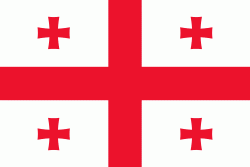Flag of Georgia (country)
The flag of Georgia (საქართველოს სახელმწიფო დროშა), also known as the five-cross flag (ხუთჯვრიანი დროშა), is one of the national symbols of Georgia. Originally a banner of the medieval Kingdom of Georgia, it was repopularised in the late 20th and early 21st centuries during the Georgian national revival.
The current flag was used by the Georgian patriotic movement following the country's independence from the Soviet Union in 1991. By the late 1990s, the design had become widely known as the Georgian historical national flag, as vexillologists had pointed out the red-on-white Jerusalem cross shown as the flag of Tbilisi in a 14th-century map by Domenico and Francesco Pizzigano. By late 2021, a newly-discovered coin of the King David the Builder with five-cross composition engraving now dates the Georgian flag to the 12th century. According to the State Council of Heraldry, the coin is of greatest importance and is an unmistakable proof for the history of the Georgian national flag being used during the reign of King David IV.
A majority of Georgians, including the influential Catholicos-Patriarch of the Georgian Orthodox Church, supported the restoration of the flag and in 1999 the Parliament of Georgia passed a bill to change the flag. However, it was not endorsed by the then-President Eduard Shevardnadze. It was adopted in the early 2000s by the main opposition party, the United National Movement led by Mikheil Saakashvili, as a symbol of popular resistance to Shevardnadze's rule as well as a symbol of the Rose Revolution.
The flag was adopted by Parliament on 14 January 2004. Saakashvili formally endorsed it via Presidential Decree No. 31 signed on 25 January, following his election as president. 14 January is annually marked as a Flag Day in Georgia.
The current flag was used by the Georgian patriotic movement following the country's independence from the Soviet Union in 1991. By the late 1990s, the design had become widely known as the Georgian historical national flag, as vexillologists had pointed out the red-on-white Jerusalem cross shown as the flag of Tbilisi in a 14th-century map by Domenico and Francesco Pizzigano. By late 2021, a newly-discovered coin of the King David the Builder with five-cross composition engraving now dates the Georgian flag to the 12th century. According to the State Council of Heraldry, the coin is of greatest importance and is an unmistakable proof for the history of the Georgian national flag being used during the reign of King David IV.
A majority of Georgians, including the influential Catholicos-Patriarch of the Georgian Orthodox Church, supported the restoration of the flag and in 1999 the Parliament of Georgia passed a bill to change the flag. However, it was not endorsed by the then-President Eduard Shevardnadze. It was adopted in the early 2000s by the main opposition party, the United National Movement led by Mikheil Saakashvili, as a symbol of popular resistance to Shevardnadze's rule as well as a symbol of the Rose Revolution.
The flag was adopted by Parliament on 14 January 2004. Saakashvili formally endorsed it via Presidential Decree No. 31 signed on 25 January, following his election as president. 14 January is annually marked as a Flag Day in Georgia.
National flag
Country - Georgia_(country)
Warning: getimagesize(/Image/Map/MP614540.gif): failed to open stream: No such file or directory in /home/mapnlee7/public_html/MAPNALL/article.php on line 532
 |
 |
During the classical era, several independent kingdoms became established in what is now Georgia, such as Colchis and Iberia. In the early 4th century, ethnic Georgians officially adopted Christianity, which contributed to the spiritual and political unification of the early Georgian states. In the Middle Ages, the unified Kingdom of Georgia emerged and reached its Golden Age during the reign of King David IV and Queen Tamar in the 12th and early 13th centuries. Thereafter, the kingdom declined and eventually disintegrated under the hegemony of various regional powers, including the Mongols, the Turks, and various dynasties of Persia. In 1783, one of the Georgian kingdoms entered into an alliance with the Russian Empire, which proceeded to annex the territory of modern Georgia in a piecemeal fashion throughout the 19th century.
